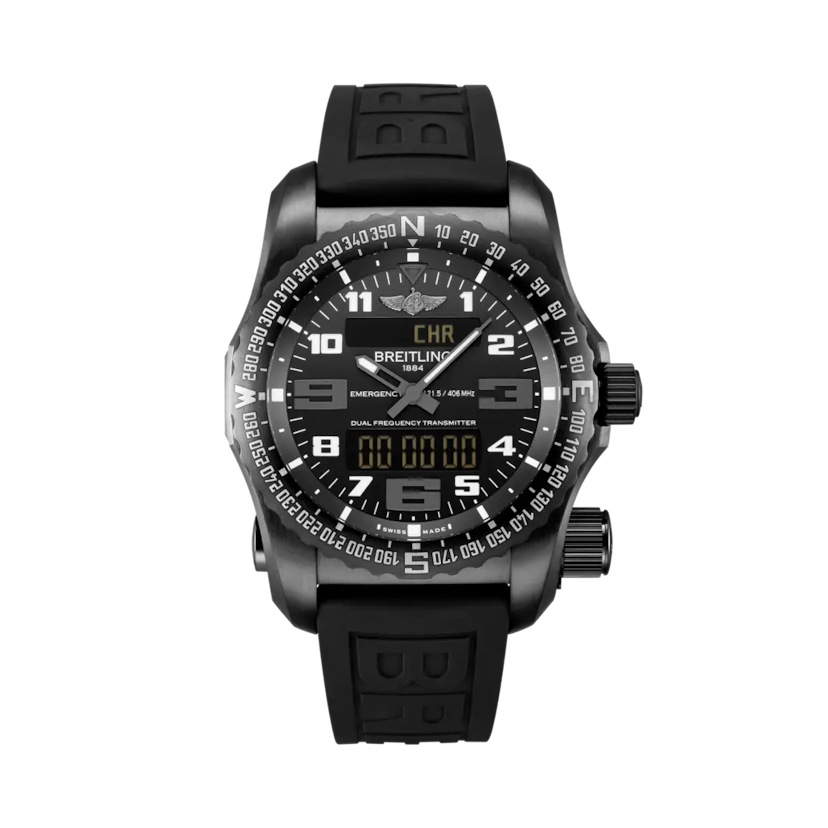Presentation
Cospas-Sarsat
Operation
Technical Data


An innovative dual frequency transmitter
The Emergency is equipped with a microtransmitter alternately operating on two separate frequencies. It transmits a first digital signal on the 406 MHz frequency intended for satellites and lasting 0.44 seconds every 50 seconds; as well as a second analog signal on the 121.5 MHz homing and rescue frequency, lasting 0.75 seconds every 2.25 seconds.
A miniaturization record
The development of this dual frequency transmitter specifically designed for the Emergency was a major technical challenge, essentially due to its dimensions that had to be adapted to the wrist. Conducted in cooperation with an institute specializing in aerospace, defense and industry, it notably involved creating a new circuit exclusively dedicated to this instrument in order to be able to transmit on two frequencies and to do so within an extremely compact volume. The result is a record in terms of both miniaturization and guaranteed reliability, which lays down new benchmarks reaching well beyond the sphere of watchmaking.




An unprecedented antenna system
The Emergency is notably distinguished by its ingenious and extremely user-friendly integrated antenna system. Its two extendable antenna “sections” housed in the lower part of the watch, are manually deployed on each side of the case. One of the main challenges consisted in finding a miniaturized device serving to transmit alternately on the two frequencies, with the antenna length varying according to the wavelength. Breitling therefore developed an original system in which, according to circumstances, the transmitter uses either part or the entirety of the two antennae – a major first on a locator beacon.
Ultra-simple handling
The beacon of the Emergency was designed to simplify handling as much as possible. Deploying the antenna automatically activates the transmitter. To do this, the user must first unscrew and pull out the cap on the main antenna on the right-hand side of the case. The cap automatically comes free of the antenna when it is deployed to the right length. This operation releases the cap of the second section, which the user can then deploy according to the same principle. A clear reminder of all the stages is provided by a series of inscriptions on the watch. Once the two antennae are deployed, all that remains is to ideally position the watch so as to guarantee the best possible transmission performance.




Controlling energy
The energy issue was a crucial element in developing the Emergency. The Cospas-Sarsat prescriptions notably demand that beacons should be capable of transmitting at a temperature of -20°C. In addition to this requirement, the dual frequency transmitter features its own specific characteristics due to its alternate operation at very different power levels (30 mW for 121.5 MHz, and 3.2 W for 406 MHz, meaning more than 100 times higher) – a characteristic that entails atypical current draw. Not to mention the need to accommodate all this within a wristwatch.
A revolutionary rechargeable battery
After considerable research, it became apparent that the ideal solution was to opt for a rechargeable battery able to deliver more power than a standard battery. There was however no product of this type that matched the profile of the Emergency. In collaboration with one of the cutting-edge institutes in this field, Breitling therefore developed a brand-new rechargeable battery specially created for this beacon-watch. A state-of-the-art product for storing energy and which has contributed to the advancement of research in this promising field.




A charger-tester for optimal security
To guarantee the reliability of the Emergency in case of necessity, Breitling has also developed a charger-tester serving to periodically recharge the battery and then to automatically check the smooth operation of the transmitter.


